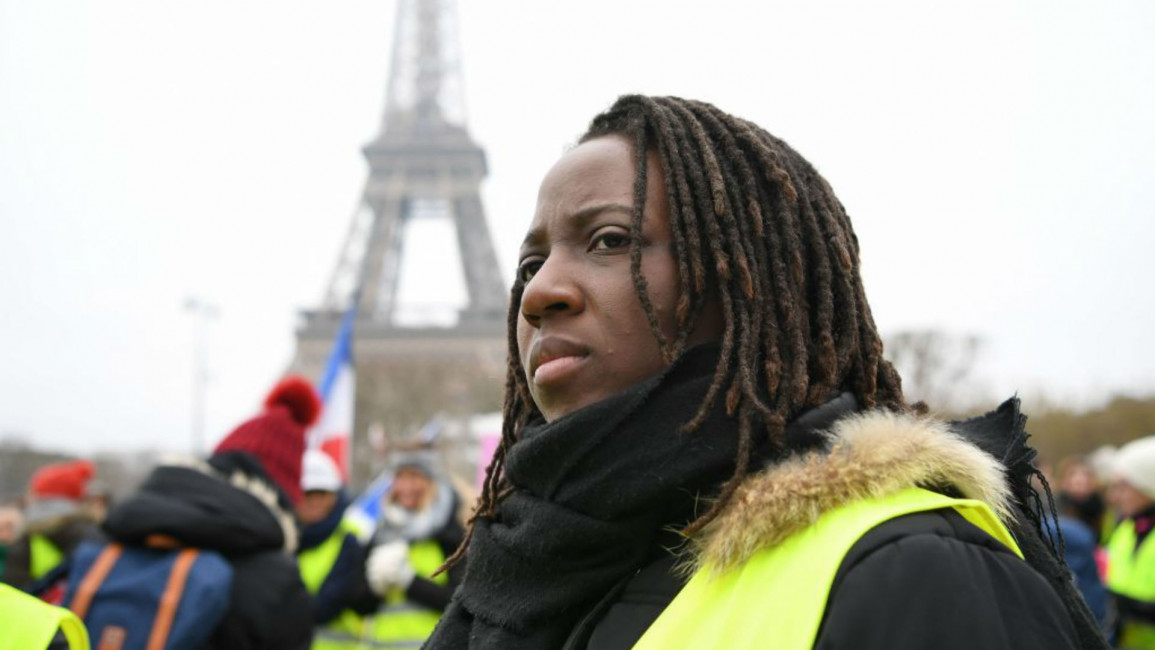
France's yellow vests are more diverse than you think
This was her response to a journalist, who asked her why the Justice for Adama campaign had joined the 'gilets jaunes' or yellow vests protests that have been taking place across the French capital, as well as other cities across the country, since November 2018.
The activist added that the collective was putting into practice what they have long preached and were joining forces to oppose Macron and his government's neoliberal agenda against the masses, as well as taking on the far-right, racists and fascists who attempt to capitalise on the yellow vests movement.
Initially sparked following Macron's plans to rise fuel prices, the yellow vests movement has since mobilised thousands to take to the streets on a weekly basis in demand of radical political change.
Rising living costs, unemployment, state brutality, precarious work and discrimination have all been key questions at the centre of a movement that some progressive sections initially hesitated to support.
Various far-right figures such as the Rassemblement National's leader Marine Le Pen had publicly endorsed the protests and attempted to capitalise on the uprising.
While this support has waned - Le Pen did not back the government's decision to raise the minimum wage in response to the demonstrations - both the French government and various commentators have repeatedly attempted to characterise the yellow vests as a far right collective.
The Comité Adama, however, along with other groups including Banlieues Respect, clearly understood the political challenges that arose upon the movement's inception.
 |
This past weekend, protests were led by women who wanted to highlight the wider social demands of the yellow vests |  |
The justice campaign and other anti-racist/anti-fascist groups put out a call to the 'banlieues' - the urban working class areas on the outskirts of large French cities - in order to rally working class communities, people of colour and migrants.
This was also to ensure that one of the most significant uprisings in recent years in France, which had Paris at a standstill during its busiest and most financially profitable time of the year, would not be co-opted.
In their statement, the Adama collective highlighted that the yellow vests and banlieues communities which are considerably racialised, share the same social issues. They are the most likely to work in precarious, and underpaid industries, in some of their areas there is up to 40 percent unemployment, in addition to police violence, racism and oppression on a daily basis.
Twitter Post
|
The reality of most of these communities is becoming unbearable, as Assa Traoré described it, "people aren't living, they're surviving".
Youcef Brakni, a key organiser in the justice for Adama also stressed that they don't believe that the far-right are at the head of the movement. Instead, they describe the yellow vests as a very diverse base whose intentions are to fight for a dignified life, not to go after Arabs and black people.
This is not to say that there are no examples of nationalist or racist symbols being mobilised at all, nor that there aren't any far right activists who take part in its actions. What it does mean is that the nature of social movements is fluid, and serves as an arena for political confrontation within which activists can intervene and shape the debate.
Read more: No, the yellow vests movement isn't Europe's Arab Spring
In the UK, there have been similar challenges to the movement. While far-right protesters took to the streets in yellow vests, union jacks and burning EU flags outside parliament earlier this month to oppose "left-wing scum" and defend Brexit, the People's Assembly Against Austerity marched in the same vests, but with a very different message.
Campaigners protested the UK government's austerity measures, poverty and cuts to public services as well as extending solidarity with migrants and people of colour. Yellow vests from France were also invited to join them on the day, which some accepted.
The fact the comité Adama and Banlieu Respect, but also the trade union, General confederation of Labour (CGT) and the railway workers have fought to unify the different struggles, points to the importance of activists refusing to characterise movements from the sidelines and the possibility of shaping the events around us.
Moreover, it is worth noting that one of the most recognised figures of the yellow vests (at least in France), is Priscilla Ludosky, a woman of Martiniquan decent, whose petition against rising petrol prices is said to have ignited to whole thing.
 |
The yellow vests movement in France is made up of a wide variety of people who have in common that they reject the status quo |  |
This is not to play into tokenstic conclusions about the movement being perfect in its representation and inclusivity, but rather it highlights the many different sections of French society which have made up the yellow vests since the beginning.
In fact, structural oppression has been key for many who have taken to the streets. Just this past weekend, protests were led by women who wanted to highlight the wider social demands of the yellow vests as well as stressing the detrimental impacts right-wing state policies have on women.
Hundreds assembled at the Eiffel Tower for the women's march, and the same took place in other cities including Bordeaux and Toulouse where 'angry mothers', 'no job security, and 'discriminated against' banners were held.
|
|
||
| Yellow vests protests spread to Martinique [YouTube] |
Similarly, the recent sentencing of Abdel Zahiri, a Muslim activist who was involved in the demonstrations, highlighted the state's violent and vengeful approach as well as the racialised nature of its repression.
Zahiri went to the police station to support a collective official complaint against police violence during the demonstrations. Instead of taking his demands seriously, the police arrested Zahiri, claiming he was threatening police officers. He was sentenced to four months in prison.
The anger and demands of the yellow vests movement are also resonating with the racialised and oppressed well beyond France's borders.
Protesters sporting fluorescent yellow vests have taken to the streets over the last few months in Martinique, Réunion and Lebanon. There also, the violence of the state, rising inequality, and poverty have sparked anger and frustration that resonates with the experiences highlighted by the French demonstrators.
While some have characterised the movement as a far-right rejection of the status quo, it's also worth noting many participants either voted for the far-left candidate Melenchon in the last presidential elections, or abstained altogether.
In reality, the yellow vests movement in France is made up of a wide variety of people who have in common that they reject the status quo, that they have been abandoned by mainstream politics, and that they are furious at their treatment by the state.
The question then is, who will give this anger a political direction, and will it turn against the powerful or the weak?
The Comité Adama, the CGT, the women's marches and others are answering this question in practice, and France's rulers are feeling the consequences.
Malia Bouattia is an activist, a former president of the National Union of Students, and co-founder of the Students not Suspects/Educators not Informants Network.
Follow her on Twitter: @MaliaBouattia
Opinions expressed in this article remain those of the author and do not necessarily represent those of The New Arab, its editorial board or staff.




